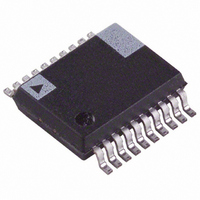ADE7760ARSRL Analog Devices Inc, ADE7760ARSRL Datasheet - Page 15

ADE7760ARSRL
Manufacturer Part Number
ADE7760ARSRL
Description
IC ENERGY METER W/OCFD 20SSOP TR
Manufacturer
Analog Devices Inc
Datasheet
1.ADE7760ARS.pdf
(24 pages)
Specifications of ADE7760ARSRL
Rohs Status
RoHS non-compliant
Input Impedance
400 KOhm
Measurement Error
0.1%
Voltage - I/o High
2.4V
Voltage - I/o Low
0.8V
Current - Supply
4mA
Voltage - Supply
4.75 V ~ 5.25 V
Operating Temperature
-40°C ~ 85°C
Mounting Type
Surface Mount
Package / Case
20-SSOP (0.200", 5.30mm Width)
Meter Type
Single Phase
Lead Free Status / Rohs Status
Not Compliant
The HPF in Channel 1 has an associated phase response that is
compensated for on-chip. Figure 20 and Figure 21 show the
phase error between channels with the compensation network
activated. The ADE7760 is phase compensated up to 1 kHz as
shown, which ensures correct active harmonic power
calculation even at low power factors.
Figure 19. Effect of Channel Offsets on the Active Power Calculation
–0.05
–0.10
–0.05
–0.10
0.30
0.25
0.20
0.15
0.10
0.05
0.30
0.25
0.20
0.15
0.10
0.05
V
1
0
0
2
× I
Figure 21. Phase Error between Channels (40 Hz to 70 Hz)
0
40
Figure 20. Phase Error between Channels (0 Hz to 1 kHz)
1
0v
100
45
200
DC COMPONENT (INCLUDING ERROR TERM)
IS EXTRACTED BY THE LPF FOR ACTIVE
POWER CALCULATION
300
V
V
50
FREQUENCY (RAD/S)
1
0
FREQUENCY (Hz)
400
FREQUENCY (Hz)
× I
× I
0
1
500
55
2v
600
60
700
800
65
900 1000
70
Rev. 0 | Page 15 of 24
DIGITAL-TO-FREQUENCY CONVERSION
As previously described, the digital output of the low-pass filter
after multiplication contains the active power information.
However, because this LPF is not an ideal “brick wall” filter
implementation, the output signal also contains attenuated
components at the line frequency and its harmonics, that is,
cos(hωt), where h = 1, 2, 3, ..., and so on. The magnitude
response of the filter is given by
For a line frequency of 50 Hz, this gives an attenuation of the 2ω
(100 Hz) component of approximately –26.9 dB. The dominat-
ing harmonic is at twice the line frequency, that is, cos(2ωt), due
to the instantaneous power signal.
Figure 22 shows the instantaneous active power signal output of
the LPF, which still contains a significant amount of instantane-
ous power information, cos(2ωt). This signal is then passed to
the digital-to-frequency converter, where it is integrated
(accumulated) over time to produce an output frequency. This
accumulation of the signal suppresses or averages out any non-
dc components in the instantaneous active power signal. The
average value of a sinusoidal signal is zero. Therefore, the
frequency generated by the ADE7760 is proportional to the
average active power.
Figure 22 also shows the digital-to-frequency conversion for
steady load conditions: constant voltage and current. As can be
seen in Figure 22, the frequency output CF varies over time,
even under steady load conditions. This frequency variation is
primarily due to the cos(2ωt) component in the instantaneous
active power signal.
MULTIPLIER
INSTANTANEOUS ACTIVE POWER SIGNAL (FREQUENCY DOMAIN)
0
H
V
I
(
LPF TO EXTRACT
ACTIVE POWER
(DC TERM)
f
)
ϖ
FREQUENCY (Rad/s)
=
Figure 22. Active Power to Frequency Conversion
1
2ϖ
=
(
LPF
f
4 /
1
5 .
Hz
)
FREQUENCY
FREQUENCY
DIGITAL-TO-
DIGITAL-TO-
2
F1
F2
CF
FOUT
F1
ADE7760
TIME
TIME
(6)












